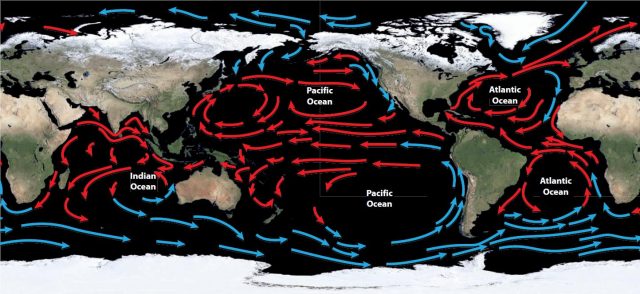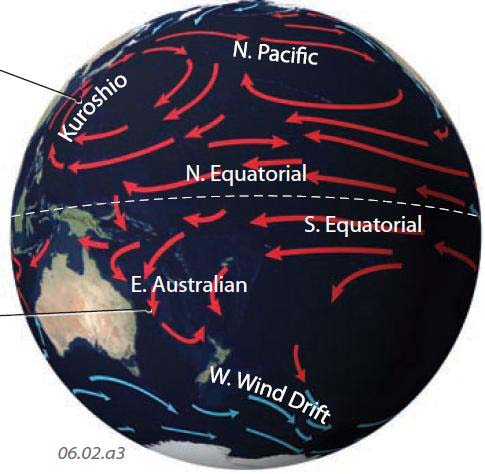What Is the Global Pattern of Surface Currents?
CONCEPTUAL MODELS OF REALITY, like the pole-to-pole ocean on the previous page, help us to draw general conclusions about the operation of physical processes. They also serve to highlight locations, or physical conditions under which the simplified overriding ideas prove inadequate in explaining observed phenomena. The global figure below depicts a summary of major surface currents and gyres in the oceans. The smaller globes and accompanying text each highlight major currents in different regions. The major currents have profound implications for the climate, weather, ecology, and the lives of the inhabitants, so take some time to learn their names.
This large map shows the locations, flow directions, and characteristics of ocean currents on a global scale. Warm currents are shown in red, and cold currents are shown in blue.

Indian Ocean
Most of the Indian Ocean lies south of the equator. Surface circulation in the Indian Ocean is dominated by the flow around the southern subtropical gyre, consisting of (1) the warm, south-flowing Mozambique Current east of Africa, (2) the cool, north-flowing Western Australian Current, and (3) a west-flowing segment of the gyre along the equator to complete the loop. South of 40° S, waters become entwined with the Antarctic Circumpolar Current. Surface flow patterns vary seasonally according to the winds of the strong Asian monsoon and other factors.

Western Pacific Ocean
The largest ocean basin on Earth, the Pacific basin, displays many of the characteristics expected from the model. It contains two subtropical gyres, one in the Northern Hemisphere and one in the Southern Hemisphere.
Northwestern Pacific: Water enters the western Pacific driven by westward flow on either side of the equator. As waters north of the equator approach the Philippines and Asia, they turn north, carrying warm water past southern China and Japan in the Kuroshio Current. At about 40° N, this flow then turns east as the North Pacific Current.
Southwestern Pacific: South of the equator, the west-flowing current turns south down the east coast of Australia as the warm East Australian Current. Farther south, it becomes enmeshed with the strong West Wind Drift, driving eastward toward South America.

Northern Atlantic Ocean
The Atlantic Ocean north of the equator consists of a wide part between North America and Africa (the central Atlantic) and a narrower part between North America and Europe (the north Atlantic). Within the central Atlantic is a subtropical gyre that includes the northerly flowing Gulf Stream, which transports warm water up the East Coast of the U.S. To the north, the Gulf Stream gives way to the North Atlantic Drift, which brings warmth and moisture to northwestern Europe. From Europe, the cooler Canary Current flows south along the coast of northwest Africa.

Southern Atlantic Ocean
The part of the Atlantic Ocean south of the equator, between South America and Africa, is the south Atlantic. Within this region is the Southern Hemisphere gyre, which includes the cold Benguela Current, which flows north along the western coast of southern Africa. After flowing west, the gyre turns south along the eastern coast of South America, becoming the warm Brazil Current. To the south, this current is deflected to the east by its interactions with the Antarctic Circumpolar Current, flowing eastward.

Arctic Ocean
Unlike its southern equivalent, the northern polar region, north of 80° N, is occupied entirely by ocean. The major outlets include the Pacific basin by means of the cold Bering Current, and the Atlantic via the Labrador and Greenland currents, which bring cool water down the east coast of Canada and Greenland. A major flow of warm ocean waters into the Arctic Ocean is accomplished by the North Atlantic Drift flowing northward along the coast of northwestern Europe.

Northern Pacific Ocean
The northern subtropical gyre in the Pacific produces a cold current, the California Current, that flows southward, down the west coast of North America. A portion of the east-moving, mid-latitude water turns north as it approaches northwestern North America, turning northward along the coast of northern British Columbia and Alaska as the Alaska Current, bringing somewhat warmer waters to these northerly latitudes. As they move west, the Alaska Current ultimately mixes with the cold waters of the Bering Current along the Aleutian Islands and the Kamchatka Peninsula of Siberia.

Southeastern Pacific Ocean
The cold waters of a current (the West Wind Drift) flowing east from Australia turn north along the west coast of South America. During this long track across the southern Pacific, the waters turn cold and form a very pronounced cold current, called the Humboldt Current (also locally known as the Peru or Chile Current). As the Humboldt Current approaches the equator, it turns back to the west, toward Australia, to complete the circuit of this huge gyre. The west-flowing segment is the South Equatorial Current.

Southern Ocean
Ocean waters surrounding Antarctica are regarded as the southern parts of the Pacific, Indian, and Atlantic oceans. No land interruptions, other than the southern tip of South America and New Zealand, exist in this region. The entire polar zone is occupied by continental Antarctica. Ocean-continent contrasts here are parallel to latitude. Strong pressure gradients and relative lack of land interruptions induce extremely strong westerly winds at these latitudes — known by sailors as the “roaring forties” and the “screaming sixties.” Circling around Antarctica is the strong West Wind Drift, also called the Antarctic Circumpolar Current.
